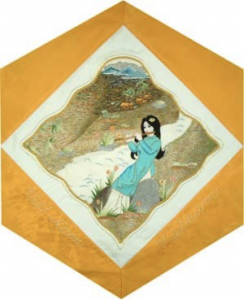Vietnam

The Block
Vietnamese embroidery, a common and social form of entertainment for women, has been worked by Oanh Attfield on a silk background, artfully blended to create a typical village scene. A young girl dressed in a traditional Aó Dãi, a high-necked tunic with a slit at the side, sits quietly by the river as she plays her sáo, a bamboo flute that has been played for thousands of years in the country.
The Aó Dãi, customarily worn with silk pants underneath and delicate sandals called guoc, is now worn primarily for special occasions. This depiction is similar to Vietnam’s image of peace, which is a little boy playing his flute while seated on a water buffalo. The majestic Truong Son Mountains, the ‘backbone of Vietnam’, and home to many rare plants and animals, soar in the distance. A double row of couched gold work undulates around the outside border softly framing the piece.
Cultural Profile
Vietnam, once called Van Lang (meaning “literate country”) is located on the eastern coast of the Indochinese Peninsula. It is comprised of three distinct regions: the north, the centre and the south. The north contains the most densely populated agricultural area in the world, the Red River Delta. The centre consists of a narrow coastal region that rises to Truong Son Mountains, and the south, in which lays the Mekong Delta, is recognized for its lush green rice paddies. Because of its topography, Vietnamese sometimes describe their country as “pole with a basket of rice on each end.” The population is relatively homogenous and almost 90 percent of the people are ethnic Vietnamese. There are also more than fifty different tribal groups, referred to as the Montagnards, the French word for highlander. Each group maintains its own traditions and native tongue. Vietnamese, a language based on up to six tones, is the official language. In it the same word can take on a different meaning depending on which tone is used by the speaker. French, English, and Chinese are also spoken.
The urban Vietnamese lifestyle has become increasingly influenced by East Asia and the West. However, the traditional way of life remains strong in rural areas. Children are taught at an early age that they owe all they have to their parents and those who came before them. The life experience of elders is highly valued, and three or four generations of one family often live under the same roof. Education is viewed as the key to success and successful individuals bring honour and prosperity to the family.
Vietnamese are known for a wide range of artistic forms, including paintings produced on framed-mounted silk, theatre, calligraphy and water puppetry. This unique form of puppetry was developed in the past centuries when rice fields would flood and Vietnamese would use them as stages. They have a long history of wood block printing, and are known for their lacquer art, mother-of-pearl designs inlaid in tropical hardwoods, ceramics, carved statues, tortoise shell items, and wickerwork such as the thung-chai, a small coracle boat. Weaving is also a widespread activity, with many villages specializing in one type of fabric. The Hmong ethnic group use resist-dyeing to produce various patterns on cotton or hemp brocade. The White Tai produce colourful fabric, while the Ta Oi use primarily black cotton with coloured stripes and integrate glass beads in the fabric as they weave it. The Cham use either black cotton or silk to weave a variety of patterns following each weaver’ imagination.
Vietnamese also love poetry and music. Court and classical music are more formal, while folk music is divided into a wide array of genres. Two instruments unique to the country are the don tranh, a sixteen-string zither and a one-stringed instrument known as a dan bau.
People began coming to Canada from Vietnam following the Second World War, and early settlers soon set the stage for the immigrant community’s growth. After 1975, thousands of Vietnamese arrived here as refugees. The majority of newcomers gravitated to large cities throughout the country, creating economic opportunities for themselves and other Canadians through the establishment of immigrant enterprises. They also formed social and cultural institutions, which facilitated their integration into Canadian life. Vietnamese journals, newspapers, magazines, radio and television programs still flourish throughout Canadian cities. Vancouver, Toronto and Montreal are home large Vietnamese populations, and Montreal even has its informal ‘Vietnam Town’ where many Vietnamese restaurants and stores can be found. The celebration of Têt (the lunar New Year) is a ritual shared by Canadians of all ethnic backgrounds that promotes awareness of the Vietnamese presence in Canada. The 2011 census reports there are over 220,000 people of Vietnamese origin now living in this country.
Sponsor: Ruby Major Andrews, in memoriam Vince Major
